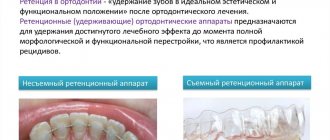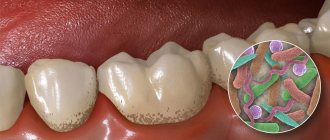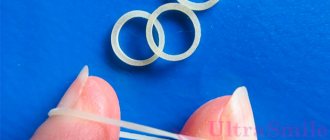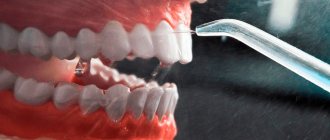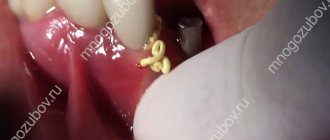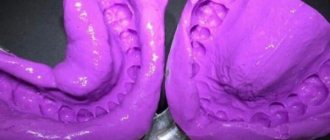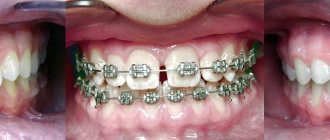When starting treatment with an orthodontist, patients should be aware that they will then have to go through a retention stage to consolidate the result. Although this stage is much easier to tolerate than treatment (we’ll talk about that later), it is nevertheless worth remembering that at this time certain efforts are required from the patient.
Both after braces and after aligners, a period of consolidation of the result is needed
Whitening after braces
Interesting fact: in Ancient Egypt, there were a kind of braces - to straighten teeth, people wrapped animal intestines around them.
Many patients express their dissatisfaction when they see white spots on their teeth after braces. Their appearance may be due to the following reasons:
- frequent smoking;
- consumption of products containing dyes;
- insufficiently good oral hygiene.
In this case, bleaching should be carried out no earlier than a month after the removal of the structure. The enamel will have time to strengthen and recover, and the tone itself will even out. If you want to carry out the procedure, you can opt for Zoom or AirFlow cleanings - some of the most gentle options.
Recommendations
To carry out orthodontic treatment, you should choose a proven clinic with good specialists. The doctor must have the necessary qualifications and sufficient experience. He will evaluate a specific clinical case and select a suitable bracket system (metal, ceramic, sapphire or plastic).
Throughout the entire correction period, you need to visit him at least once a month so that he monitors the process. If the device breaks down or the locks come off, you should immediately contact an orthodontist to quickly fix the problem.
In addition, the doctor gives advice that will help maintain the integrity of tooth enamel. If you follow them, you can minimize the negative impact of braces on your teeth.
Sanitation of the oral cavity
Before installing the braces system, you need to completely sanitize the oral cavity. The following activities are carried out:
- Replacing old and cracked fillings. Orthodontic construction creates increased stress on the teeth.
- Treatment of caries.
- Treatment of gum diseases (stomatitis, gingivitis, periodontal disease). Braces lead to exacerbation of even minor inflammatory processes.
- Professional teeth cleaning. Removing soft plaque and tartar. For these purposes, ultrasound or preparations with fluoride compounds are used.
- Remineralization.
Nutrition
To protect your orthodontic structure from damage, you will have to carefully monitor your diet. First of all, you should avoid viscous and hard foods. These include:
- toffee;
- nuts;
- fresh vegetables and fruits (apples, carrots and many others);
- seeds;
- crackers;
- candies;
- dried fruits;
- chewing gum.
Also, you should not eat too cold or hot food, because there is a risk of peeling of the locks and deformation of the vestibular arches.
Products containing strong coloring pigments are prohibited. For example:
- coffee;
- tea;
- beet;
- some berries.
Quality care
Hygiene is one of the main factors in minimizing the negative effects of braces on tooth enamel. It is advisable to brush your teeth after every meal with a special toothbrush. If this is not possible, then at least twice a day (morning and evening). The rest of the time you need to rinse your mouth after eating.
Also, orthodontists advise using additional devices when performing hygiene procedures:
- floss;
- pipe cleaners;
- mouth rinses with antibacterial effect;
- tongue scrapers;
- irrigator.
It is better to choose toothpaste with a therapeutic and prophylactic composition.
If the patient uses an electric toothbrush, then you need to choose a two-speed one with vibration movements in two directions.
Restoring tooth enamel after braces
Demineralization of enamel after braces is a fairly common occurrence. If efforts are not made to combat it, serious problems may arise. The fluoridation procedure allows you to restore the enamel. There are several types:
- a procedure consisting of applying a special gel;
- local fluoridation with varnish;
- using a retainer with a special composition inside.
The dentist can also suggest the most effective paste or other substance to reabsorb lost minerals.
Responsibilities of the patient during the retention period:
1.Regularly wear removable retainers in the manner indicated above. In case of significant breaks in wearing removable retention devices, the position of the teeth may change and the aesthetics of the smile and bite may deteriorate. Installation of the device may not be possible after a break due to these movements (the device does not fit the new situation, is not worn). In this case, it is necessary to manufacture a new retention device, and sometimes repeat orthodontic treatment according to the currently valid price list. The retention device cannot fail to fit (not be put on) provided it is worn regularly, just as teeth cannot significantly change their position provided the retention device is regularly used in the proper manner. 2. Be sure to take removable retainers with you on trips lasting more than one day. 3. In case of breakdown or loss of any retention device, you must immediately contact the clinic. 4. Every day when brushing your teeth in the evening, you need to pay attention to the integrity of non-removable retainers. If you have any suspicions that the upper or lower retainer is broken or has become unstuck in the area of at least one tooth (you can feel the metal of the wire, mobility, etc.), you must start using a removable retention device on this jaw for at least 12 hours a day and urgently make an appointment with an orthodontist at our clinic. You must bring removable retention devices to your appointment. It is also necessary to do this if, during periodic self-examinations, you suspect that there are unfavorable changes in the bite or position of the teeth (rotations, gaps, etc.). 5. It is necessary to maintain good hygiene of fixed retainers using standard hygiene products and Super Floss (special dental floss). Retainers make it difficult to maintain a good level of hygiene on the inside of the teeth and between the teeth. Insufficient hygiene may result in the appearance of plaque and hard dental deposits, inflammation of the gums, bad breath and bleeding gums. Once every 6 months it is necessary to carry out professional dental hygiene in the clinic in order to prevent the above complications.
How long does this stage last?
The standard period for adults is twice as long as the treatment lasted. That is, if the active stage of tooth movement has passed in 12 months, the retention stage lasts at least 2 years. But this is an average period. In each specific case, the doctor determines the duration of the consolidation stage individually.
It is important to note that there is no way to determine whether the teeth are securely anchored in their new location. And if you stop the retention stage too early, then there is a risk that in a month or two the teeth may move into the wrong position, and this will happen unnoticed. Most likely, not to its original state, but even a slight deviation can make the smile less ideal.
Therefore, it is much better to play it safe and wear stabilizing aligners a little longer, but maintain the result.
Currently, even the treatment process itself is quite simple and comfortable. The aligners cause minimal inconvenience and are very easy to get used to. And compared to the stage of active tooth movement, the retention period is even easier, because during the daytime there is no need to wear aligners at all.
What orthodontic structures are used at this stage?
A permanent retainer is usually placed on the lower teeth. This is a thin metal wire made of the same alloy as the braces arch and about the same thickness. The retainer is installed from the reverse (lingual) side using filling material. The surface of the retainer and fastenings is smooth, does not interfere with cleaning and is not felt at all.
This is what a dental retainer looks like
But the retainer only holds the lower teeth in place. To stabilize the position of the upper ones, use a transparent mouth guard. It is made from impressions that are taken from the teeth immediately after treatment is completed. That is, the mouthguard repeats the ideal shape of the dentition that was obtained as a result. The mouth guard must be worn at night.
How to care for retainers
Without braces , oral care, of course, is not canceled, but it is still significantly simplified. Patients with fixed retainers must adhere to the usual rules for caring for teeth and orthodontic structures.
Caring for removable retainer mouth guards is as simple as possible, the main thing is not to damage the integrity of their design. The plate must be washed daily in running water and cleaned using a soft toothbrush. To prevent the mouth guard from accumulating plaque, it should be disinfected weekly by placing it in a special solution for a while. Removable retainers can be removed for meals.
It is also necessary to observe the temperature regime: from exposure to high temperatures, a silicone plate made to the shape of the teeth can become deformed and stop performing its task. Removable retainers are stored in a special dental case, which has compact dimensions and is equipped with special holes.
Pros and cons of retainers
Among the advantages of such elements:
- Aesthetic appearance. Since they are attached to the back of the teeth, they are absolutely invisible to others.
- There is no need to control the wearing of the product. A person cannot forget to put on a retainer because it is constantly in his mouth.
- Guaranteed good results. Any element located in the oral cavity causes some discomfort. Then a person can consciously remove it for one or several days. This leads to a “rollback” in treatment. You cannot remove retainers and then put them on yourself. And this is good.
As for the minuses, these are:
- Difficulties in carrying out hygiene procedures. As in the case of braces, the patient has to use an irrigator, floss, and a properly selected brush in order to efficiently clean the enamel from plaque.
- The need to avoid eating hard and sticky foods. They get stuck under the archwire or stick to it, which complicates hygiene.
- Inability to fix a loose element yourself. If it happens that some part of the retainer comes away from the teeth, the patient needs to immediately go to the dentist. He won't be able to do anything at home.
Trust your doctor and use exactly the leveling device he told you to use. Do not try to arbitrarily shorten the duration of the retention period. This will ruin all your progress. Then you will have to re-install braces and start all over again.
To be or not to be wisdom teeth?
Pay attention to the partially cut “eights” (pictured). The Dial-Dent clinic pays considerable attention to the issue of treatment and, if necessary, removal of wisdom teeth.
Comment by the chief physician of the clinic S.V. Tsukora: “Removing the eighth teeth (especially the lower ones) is the most difficult removal of them all possible. It is fraught with a number of unpleasant phenomena and complications: loss of sensitivity along the nerve, difficulty opening the mouth, swelling, inflammation of the socket. Therefore, “eights” are not removed on purpose, without strict indications.
If there are indications, for example, caries, inflammation of the nerve in the eight (pulpitis), malocclusion, impaired closure of teeth, a gum pocket (hood above the eight), damage to the seventh from an incorrect eighth tooth, then a decision is made to remove it!
The tactics at Dial-Dent when removing figure eights are as follows: first, we remove wisdom teeth under anesthesia (sedation). It is not painful at all, not scary, there is no memory of the intervention. Second, we remove all problematic eights at once. I don’t understand the tactic of charging a month a month. Each time there may be swelling, pain, risk of complications, and each time it is possible to take antibiotics. For what?! I fell asleep, woke up - all my wisdom teeth were removed! After removal under sedation, the patient feels 100 times better than when it is done under local anesthesia.”
After analyzing the images, doctors decided not to remove wisdom teeth, since there is no indication for this. The girl is recommended to undergo regular preventive examinations to monitor the condition of her wisdom teeth.
Before starting complex treatment, the patient was recommended to remove the almost completely destroyed tooth from below, since it could not be restored.
Dentist consultation
When planning an aesthetic restoration, the patient consultation begins with a photo session. Photographs help the doctor, together with the patient, visually analyze the defects. The patient voices his wishes, and the doctor talks about possible options for solving the problem. The doctor also takes several x-rays to clarify the diagnosis. Next, a treatment plan and estimate are drawn up.
The attending physician presented the patient with the following comprehensive treatment plan:
- Dental treatment with a microscope, replacing fillings in chewing teeth with ceramic inlays.
- Removal of a decayed tooth in the lower right.
- Dental implantation (lower “sixes”).
- Orthodontic teeth straightening.
- Teeth whitening.
- Aesthetic restoration (ceramic veneers and ceramic crowns on the front teeth) and prosthetics on implants to restore missing teeth.
For financial reasons, as well as due to lack of time for implantation, the patient asked to change the treatment plan and postpone the stage of restoration of the chewing teeth to a more favorable moment for her. Since the entire treatment process could be divided into several stages without loss for the patient, the doctors agreed to shorten the treatment plan and concentrated on restoring the aesthetics of the front teeth. The patient signed a waiver of full treatment.
Dial-Dent specialists who performed this work:
- Orthopedic dentist Tsukor S.V. — treatment planning, aesthetic dental prosthetics.
- Orthodontist Sleptsova M.P. — teeth straightening with braces.
- Dentist Borisova Yu.A. — dental treatment with a microscope.
- Dental technician Volk D.V. — production of ceramic crowns and ceramic veneers.
- Speech therapist Tsukor T.B. — sound pronunciation correction.
- Hygienist Smirnova E.P. — ZOOM teeth whitening.
- Dental assistants Kharlamova L., Antoshkina A.
See other examples of comprehensive solutions to dental problems here.
What's missing from a changed smile?
As a rule, by an ideal smile, orthodontic patients who have just embarked on a complex, long-term path of orthodontic treatment understand ideally evenly positioned teeth. And after the braces are removed, the reward really is an even row of teeth in the correct position. The more obvious become smaller, insignificant flaws, which previously simply faded against the background of crowded crowns turned in different directions.
The thing is that treatment with braces changes the location of the teeth, but is not able to change their shape and the color of the tooth enamel. No matter how the orthodontist moves the teeth, the smile will not become perfect if the teeth have certain defects.
The aesthetics of the dentition is impaired by:
- chips;
- darkened areas, yellowed enamel;
- pathologically worn cutting edges of the central incisors;
- lack of symmetry of teeth located in the smile zone;
- small interdental gaps;
- asymmetrical edges of teeth subjected to separation (grinding) during the correction of crowded teeth with braces.
Unfortunately, not all orthodontic centers in Moscow plan the process of bite correction together with specialists in the field of aesthetic dentistry. And not in all cases, dentists will be able to tell during a preliminary consultation whether the patient will need correction or not.
Therefore, some lucky people who have had their braces removed are disappointed with the results at the end of treatment: their expectations of a Hollywood smile were not met, and they were not ready for the next financial investment.
Your questions
Good afternoon Please tell me, is it worth putting braces on a child at 12 years old?
Please advise what is better – veneers or braces?
The question is: is it possible to do an MRI with braces?
I heard that there are braces that are only worn at night. Is it so?
This morning I saw that one of my braces had come off. What to do?
Hello! Tell me, is it necessary to remove a tooth with braces?
What recommendations and tips are there when wearing braces?
Tell me, do braces correct your bite?
Do installed braces affect diction?
Tell me, do they put braces on 1 jaw?
The result of complex dental treatment
Results of complex dental treatment: all tasks were completed, the patient is satisfied with the result. It is recommended to undergo dental prosthetics in the near future to stabilize the results of teeth alignment. Without timely prosthetics, antagonist teeth, as well as teeth adjacent to the missing one, gradually shift, which can lead to problems with bite and diction.
As it turned out later, the girl postponed prosthetics for her chewing teeth for 10 years. It’s nice to look at the results of teeth restoration with veneers after 10 years - the veneers look just as good, they haven’t changed color, there are no chips. Fortunately, after 10 years the teeth did not move and the dental prosthetics were successful. Details here.
Is it possible to change the situation?
1. If desired, bringing your smile to perfection will not be difficult and will not always require significant investments. After all, the first, most important, most necessary stage has already been completed. Orthodontic treatment corrects your bite, straightens your teeth, and prevents more serious dental problems. And modern methods of artistic (or aesthetic) dental restoration will help restore the aesthetics of the dentition.
2. Adults are able to solve the dilemma themselves: whether to continue treatment if they don’t quite like the smile, or limit themselves to the achieved result.
When is it time to remove braces?
Typically, the duration of wearing braces depends on the severity of the pathology and the age of the patient. The more complex the clinical case and the older the person, the longer it takes to straighten the teeth. However, the first changes are noticeable within a few months after fixing the system. When it is clear that it is time to remove the braces, the doctor will inform you about the expected end date of treatment.
The process of correcting the bite can take from several months to 2 years. An experienced and highly qualified orthodontist is able to select the most optimal correction scheme that allows you to achieve your goal in the shortest possible time. If you strictly follow all the instructions, the day when you need to remove your braces will not be long in coming.
